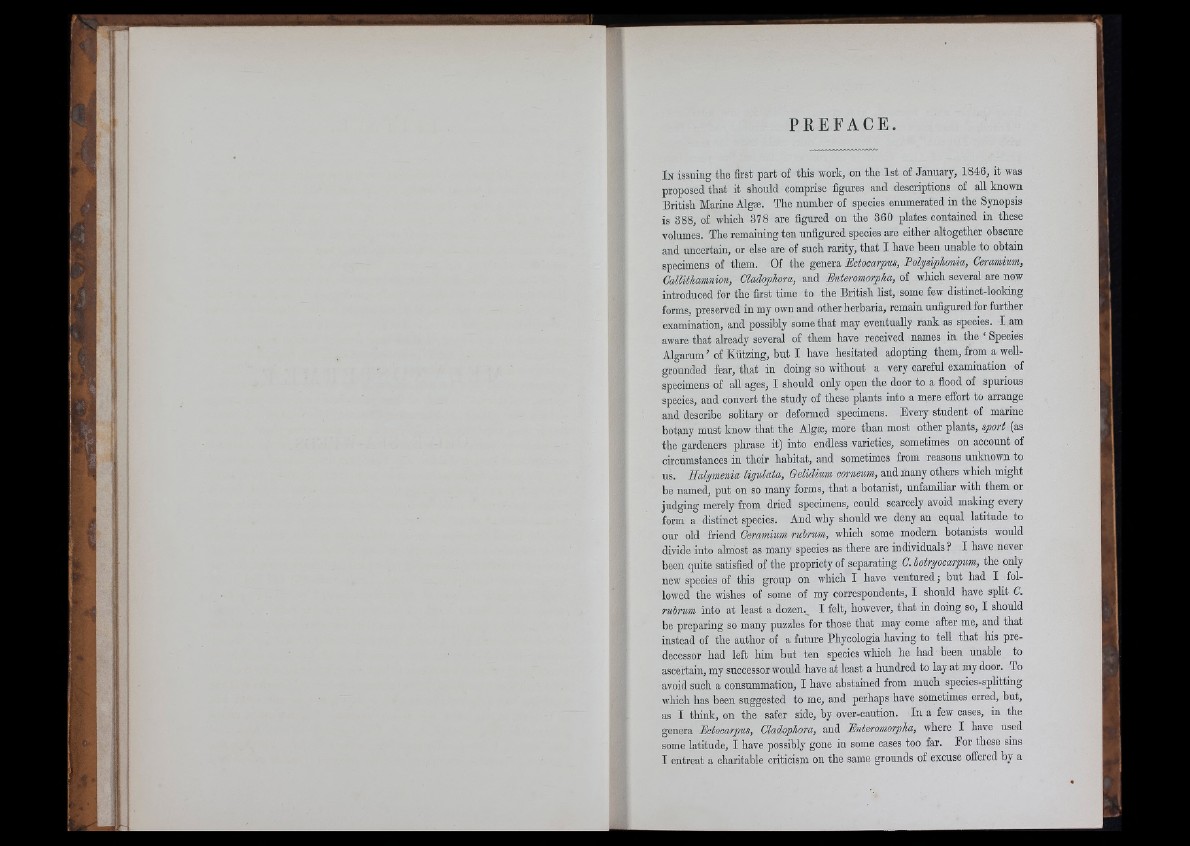
'
P R E FAC E .
I n issuing th e first p a rt of this work, on the 1st of January, 1846, it was
proposed th a t it should comprise figures and descriptions of all known
British Marine Algee. The number of species enumerated in the Synopsis
is 388, of which 378 are figured on th e 360 plates contained in these
volumes. The remaining ten unfigured species are either altogether obscure
and uncertain, or else are of such rarity, th a t I have been unable to obtain
specimens of them. Of the genera Ectocarpus, PolyaipJionia, Ceramium,
CaUitliamnimi, Cladophora, and Mteromorpha, of which several are now
introduced for th e first time to the British list, some few distinct-looking
forms, preserved in my own and other herbaria, remain unfigured for further
examination, and possibly some th a t may eventually ran k as species. I am
aware th a t already several of them have received names in th e ‘ Species
Algarum ’ of Kutzing, b u t I have hesitated adopting them, from a well-
grounded fear, th a t in doing so without a very careful examination of
specimens of aU ages, I should only open th e door to a flood of spurious
species, and convert the study of these plants into a mere effort to arrange
and describe solitary or deformed specimens. Every student of marine
botany must know th a t the Alg®, more th an most other plants, sport (as
th e gardeners phrase it) into endless varieties, sometimes on aooount of
circumstances in th e ir habitat, and sometimes from reasons unknown to
us. Ealymenia ligulata, Qelidium cornewm, and many others which might
be named, p u t on so many forms, th a t a botanist, unfamiliar with them or
judging merely from dried specimens, could scarcely avoid making every
form a distinct species. And why should we deny an equal latitude to
our old friend Ceramkm ruhrum, which some modern botanists would
divide into almost as many species as there are individuals ? I have never
been quite satisfied of th e propriety of separating C. hotryocarpum, th e only
new species of this group on which I have ventu red ; b u t had I followed
th e wishes of some of my correspondents, I should have split C.
mbrum into at least a dozen.^ I felt, however, th a t in doing so, I should
be preparing so many puzzles for those th a t may come after me, and th a t
instead of the author of a future Phycologia having to tell th a t his p re decessor
had left him b u t ten species which he had been unable to
ascertain, my successor would have at least a hundred to lay a t my door. To
avoid such a consummation, I have abstained from much species-splitting
which has been suggested to me, and perhaps have sometimes erred, but,
as I think, on the safer side, by over-caution. I n a few cases, in the
genera Ectocarpus, Cladophora, and Enteromorpha, where I have used
some latitude, I have possibly gone in some oases too far. Eor these sins
I entreat a charitable criticism on the same grounds of excuse offered by a